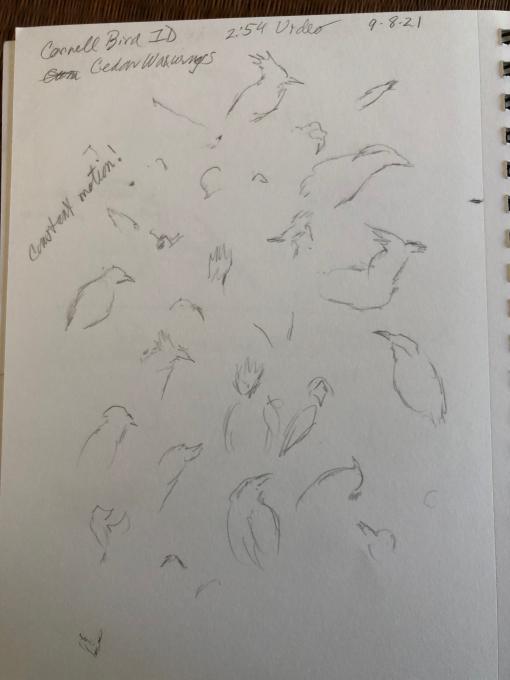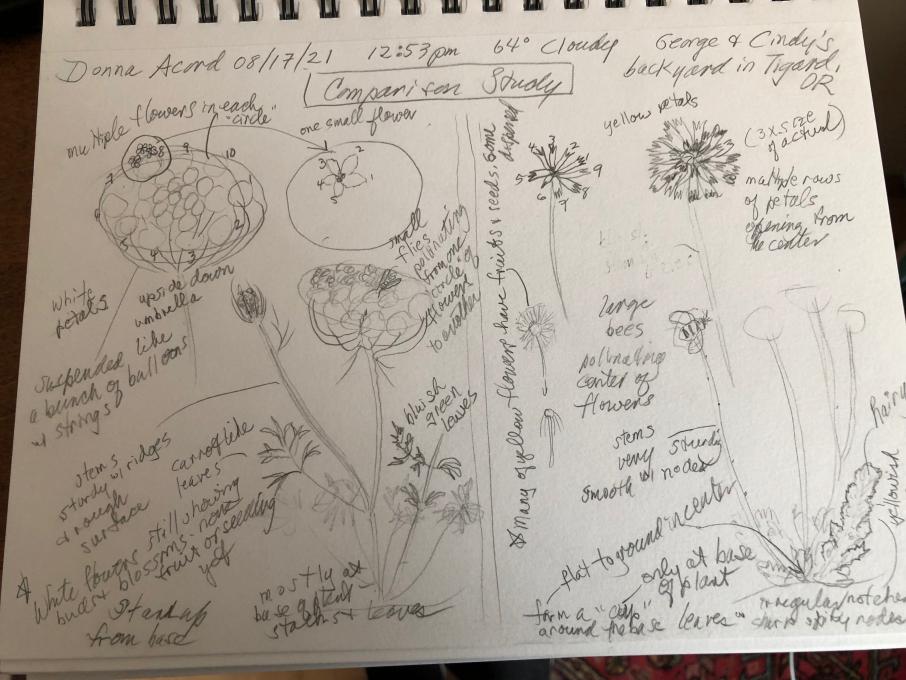Donna
Forum Replies Created
Viewing 9 posts - 1 through 9 (of 9 total)
-
DonnaParticipantGesture drawing is helping me to pay closer attention to details of movement, habits of movement, and I am watching the moving animal more than looking at my paper, because if I look down too much, I lose the subject, it has moved on. That said, it is rather challenging. My goal now is to be able to go back to poses I captured and add to them, rather than creating a new sketch each time the animal moves.in reply to: Capturing Behavior – Gesture Drawing #835862
-
DonnaParticipant
 in reply to: Capturing Behavior – Gesture Drawing #835861
in reply to: Capturing Behavior – Gesture Drawing #835861 -
DonnaParticipantI definitely had to stay focused on the subject. I made an effort to find something I liked in each drawing. The plants I tried were too complex to have anything resembling the images on my page. I found it challenging to have proportions once i was working on the "second half" of an image; I would over shoot or overlap. Not sure what is going on there, I don't seem to be able to hold the place in space of the parts of the image. example, the two sides of the Springbok's legs.in reply to: Focusing on Your Subject – Blind Contour Drawing #835751
-
DonnaParticipantI noticed that both plants in my comparison study were blooming alongside each other. Each had a very different flower structure. I watched pollinators landing on each of them. but the pollinators were different on each one. The plant with "umbels" had such tiny "sub blossoms," that only little flies could alight on them. The the dandelion light composite flower blossom, it provided a much wider landing pad, so I saw large bees on these. I wonder if this is part of what allows them to be reproducing side by side? They would not have to compete for pollinators, as they each attract different kinds. I wonder what else about them allows them to not be competing? Perhaps they take different nutrients from the soil? A commonality is that they both need full sunlight and seem to do dwell in drought conditions. There was also plenty of space for them. One of the flowers seemed to be much farther along in its phenology cycle. The white "umbel" plant was only just starting its blossoming, had both buds and blossoms. The yellow dandelion like plant was exhibiting mulitple stages, flowers, fruits and seeds, some of which were already dispersing. So the yellow one was farther along it is reproductive cycle than the white one. I wonder if that is another reason that they can co-exist? They need different levels of nutrients at different times?in reply to: The Power of Comparison #835747
-
DonnaParticipant
 in reply to: The Power of Comparison #835745
in reply to: The Power of Comparison #835745 -
DonnaParticipantOne theme I noticed was Systems and Energy Flow. I observed two species of slugs on my hike to my sit spot. One was carrying some fir needles in its mouth, slowing moving across the trail. Possible Explanations: 1. It eats fir needles because they are plentiful and available when they have fallen to the ground. 2. It acts as a natural "composter" 3. It is clearing the forest floor of dead material, as part of a system of other life forms that eat dead or decaying life. Questions: Do slugs always eat "waste material?" Things that are no longer alive? I wonder if they ever crawl up on a rock or tree to look for food? I have only ever seen them on the ground. What other life forms help to decompose things in the forest?in reply to: Noticing Themes in Nature #831177
-
DonnaParticipantMy journal was all written observations. I was doing a sitting survey of American Pikas, as a Citizen Scientist. They have been moving as glaciers are melting. The Oregon Zoo is supporting a project to monitor the movement of pikas into the Columbia River Gorge, and in some lower elevations around Mt. Hood. I was in the Gorge this morning. I did not spot any pikas, but heard their very characteristic "long" calls. If I had seen them, I would have taken a photo, although I do not have a powerful lens. I am comfortable with recording GPS locations, temperature, other weather conditions, time, date, etc. On my hike in (2 hours) I also recorded other observations - plants I saw, other small mammals I encountered, and birds. It was all in words. Out of my comfort zone would have been to draw or sketch these observations. I would like to do that, but haven't figured out how I could do so quickly. The actual PikaWatch part involved 20 minutes of intense searching with my binoculars. But I was on the spot for about 45 minutes, recording and observing what else was there. It was on a narrow trail, though, and other hikers occasionally came through.in reply to: Opening Your Senses #831170
-
DonnaParticipantIt was a bit challenging, but not overwhelming. I drew some ovals and circles, like D.J. had done. that helped. And then kept making a lot of adjustments, erasing, redrawing. Trying to get proportions and angles of the bill, tail, legs, wings, with respect to each other. I just did pencil for now, but if I had painted in color, I think I'd recognize it. It was fun to try this. And just that one tip from D.J. helped me get started. As I drew, I kept noticing more about the bird, that I did not pick up on first glance, such as all the detail in the wings. With photos, I have mainly looked at those reddish streaks on the yellow breast. Also, shape of the bill, angle to the head, size of the eye. Doing this drawing, I realize that by doing the nature journaling, I will cultivate my observation skills and attention to detail. Even the stance of the bird, its posture, and I wonder, what is the habitat, what kind of tree is it sitting on? These are things I would try to draw and take notes on, to investigate later.in reply to: Jump Right in! #817918
-
DonnaParticipant1. Being out in nature and observing plants, landscape and birds has been my grounding place during this pandemic. I participate in a couple of citizen science projects, which I love doing and have also been restorative, especially during this time. I think the nature journaling would enhance this experience and develop my observational skills. Plus, I have wanted to learn to draw and paint birds since starting birding a few years ago when I retired, but thought, I'm not an artist. It resonates more with me than photographing what I see. And Liz says we all can be artists! 2. I liked the balance of observations and visuals in Shayna, Liz and D.J.'s journals. I will use the boxes, at least at first, the way Shayna evolved them. I also really like her "zoom lens" to show detail. I want to pay attention and record my impressions of the visual beauty, even if I don't have time to draw and paint it all - as Liz said, these triggered memories for her. I especially appreciated D.J.'s attention and focus on behavior of birds and other animals. Several of the journalers referred to questions and curiosity arising, and going away to research and learn, then returning to the journal to record what they discovered. I very much would like to do that - to become absorbed in something triggered by my observations, and enhance my knowledge as a naturalist. This also brings up another thing that appeals to me about nature journaling - and the reason I was captivated by birds on retiring. I slow down, lose track of time, and feel connected to something larger than myself of my human world. It is very relaxing and peaceful. It is meditation. 3. Being in nature is my cathedral. I think the journal will help to evoke that for me, even when I am indoors. I took a class on writing haiku last winter. I think I will sometimes be evoked to do that by something I observe, or write about a memory that has been recalled, or a prayer that has been inspired. I may also sometimes include an inspirational quote, such as Liz as done in the text for this course. So while it will mostly be more science oriented, I think adding the art points out the beauty of nature, which does bring up a spiritual component for me.in reply to: Style Your Journal Your Way #817879
Viewing 9 posts - 1 through 9 (of 9 total)

